Remaining compact in various areas of the pitch is vital in order to prevent your opponent from finding space + time to play!
The following session develops the ability to remain compact in central areas of the pitch.
Mick McDermott has held coaching positions in multiple countries over the past 15 years; he is currently Assistant Coach at Esteghlal F.C (Tehran, Iran) – one of Asia’s most powerful clubs.
Prior to Esteghlal he spent 10 years in various roles in the Middle-East including Al Ain FC, Al Nasr FC and with the Iran National Team during their World Cup 2014 qualification campaign.
A native of Belfast (Ireland), Mick spent over a decade in USA prior to moving to the Middle-East; while in USA he held various coaching roles at the Youth, College + Professional level.
He currently holds both UEFA + USSF ‘A’ Licenses.
1.
Setup:
12 Players split into 3 groups of 4. One team designated as ‘Defending’ team for the designated time (Black in Diagram). Other players positioned on perimeter; 2 Players position centrally (Yellow).
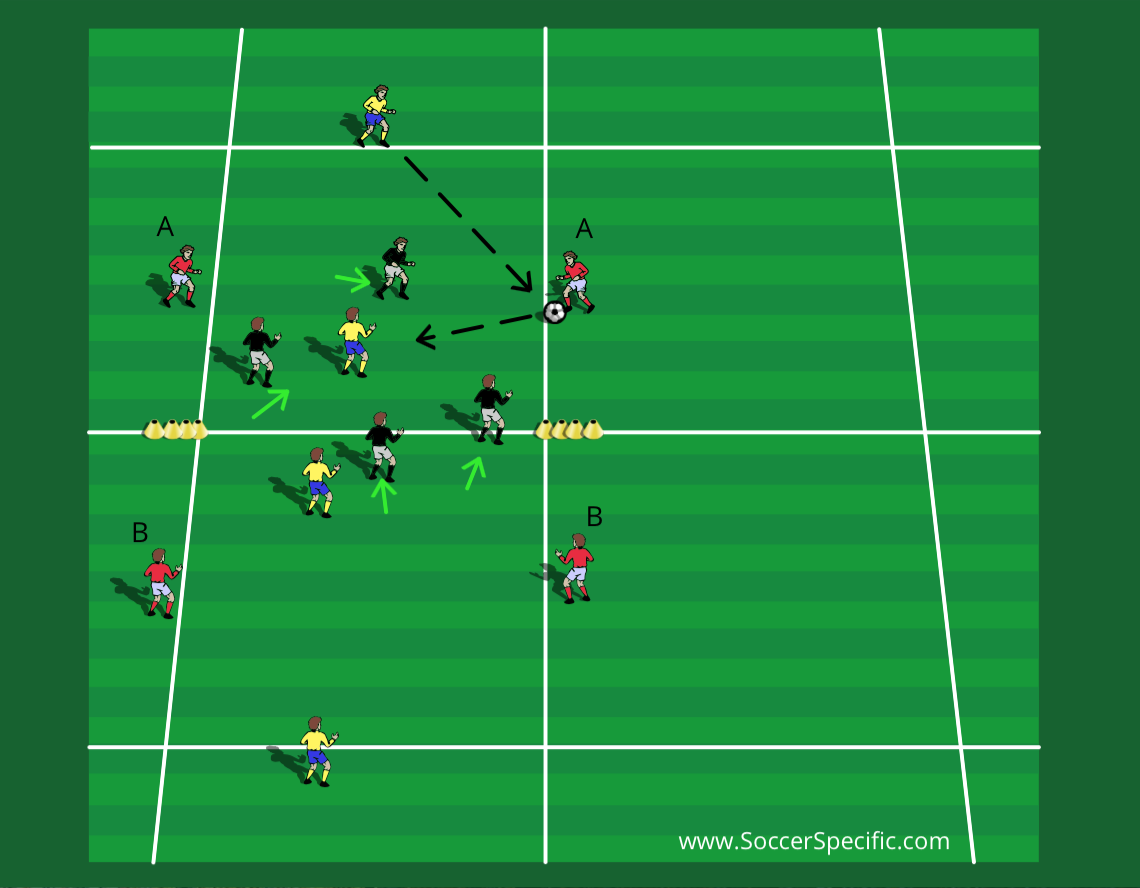
Instructions:
POSSESSION 8v4 – DEFENSIVE ORGANISATION:
Yellow + Red teams must maintain possession through quick ball circulation – 10 passes = 1 goal / splitting the Defensive 4 with pass = 3 goals.
*Note: Players (A) + (B) cannot pass to each other – pass is blocked with cones – this is to encourage central passes.
Emphasis is on the DEFENSIVE team remaining compact to deny passes to central players, to deny splitting passes and also to press when appropriate to win possession.
Coaching Points:
- DEFENSIVE TEAM:
- Stay Compact centrally
- Deny passing lanes to central players
- Communication is vital
- POSSESSION TEAM(S):
- Quick ball circulation and movement.
2.
Setup:
SQUAD SPLIT INTO 2 GROUPS – (1) Back-4 Defending, (2) Midfield Defending.
(1) BACK-4 DEFENDING –
12 Players organised as follows:-
Back-4 (Black)
7 Other players to circulate the ball; 1 Central Player acting as a Striker (S).
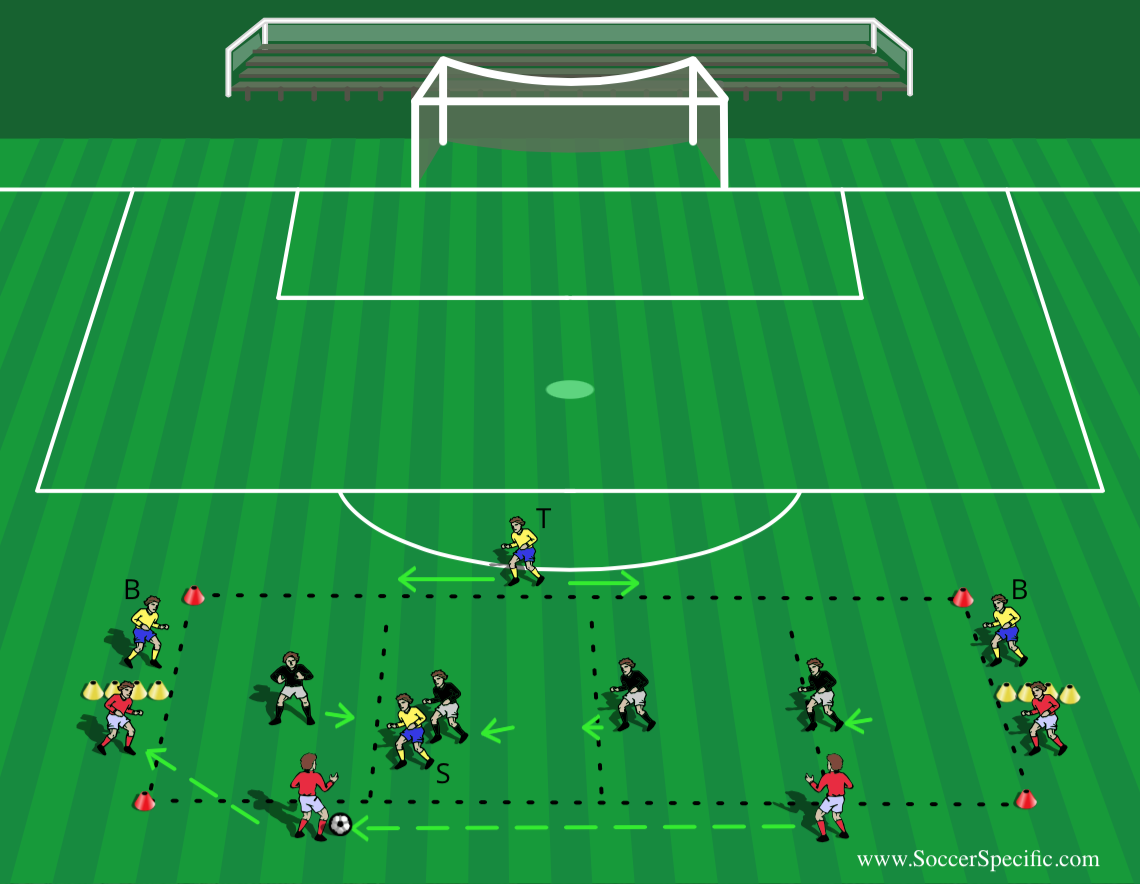
Instructions:
DEFENSIVE ORGANISATION – Central Compactness:
Perimeter / Central Players circulate the ball and attempt to play splitting passes to the Target Player (T) or to the advanced perimeter players (B).
Emphasis is on the Defensive Compactness of the Back-4: Players must move as a unit to deny the passing options as well as Press the Striker when receiving short passes to feet.
Coaching Points:
- DEFENSIVE TEAM:
- Stay Compact centrally – must avoid being ‘too compact’ – if too compact this can result in easy passing options to Perimeter Players (B).
- Press central Striker while teammates close passing channels.
- Communication is vital
- POSSESSION TEAM(S):
- Quick ball circulation and movement.
3.
Setup:
SQUAD SPLIT INTO 2 GROUPS – (1) Back-4 Defending, (2) Midfield Defending.
(2) MIDFIELD DEFENDING –
12 Players organised as follows:-
Two groups of (4) Midfield Players; 2 players on each team designated as Forwards (F).
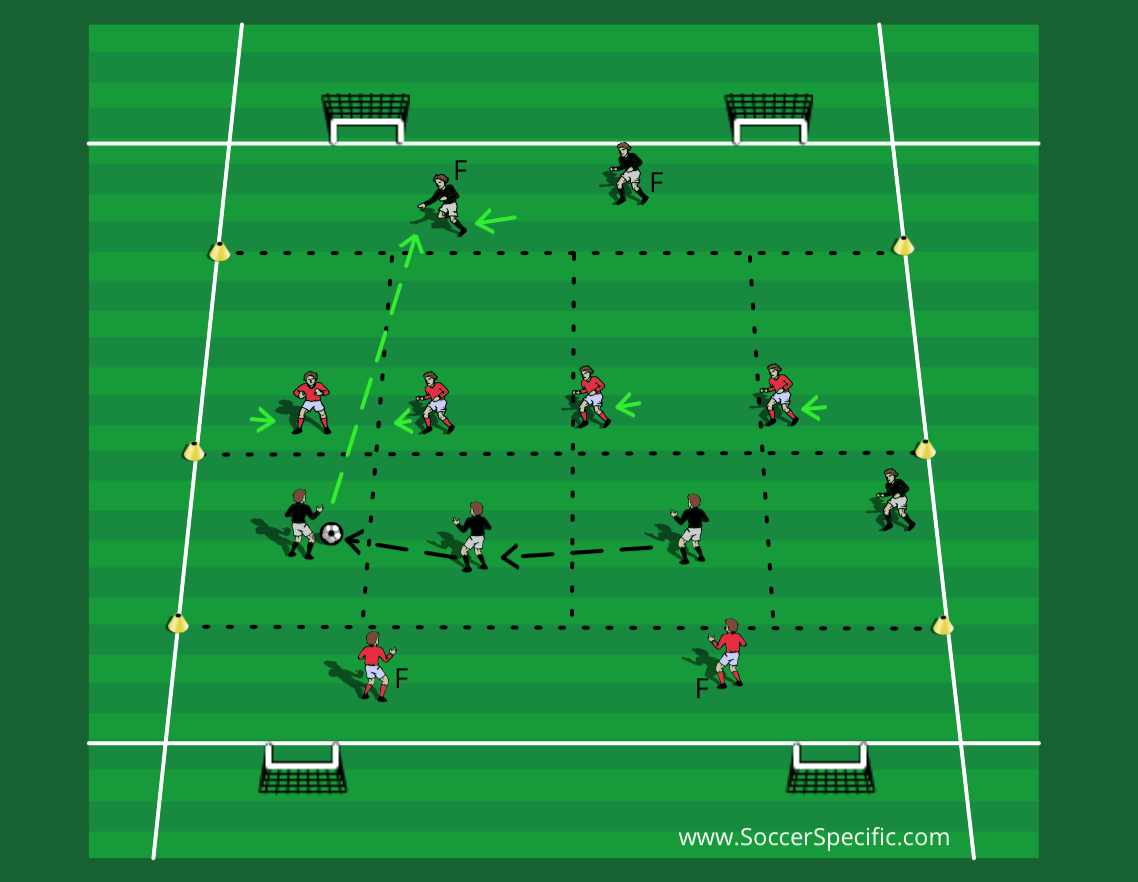
Instructions:
DEFENSIVE ORGANISATION – Central Compactness / Pressing:
One group of Midfield Players circulates the ball quickly in the playing area and attempts to pass to the advanced Forwards (F) to score in mini goals; 1-touch play encouraged. Emphasis is on the Defensive compactness of the Midfield block; Defending players must stay in their designated zone while denying passing channels to Forwards.
**If a pass goes to the Forwards; Midfielders must immediately turn and Press the Forward from the front-side to regain possession. Forwards must complete one pass to each other before scoring – this gives a few seconds for Midfielders to turn / Press!
Coaching Points:
- DEFENSIVE TEAM:
- Stay Compact centrally – stay in own channel!
- If split – turn IMMEDIATELY to press the Forwards.
- POSSESSION TEAM(S):
- Quick ball circulation and movement – players are free to change channels.
4.
Setup:
11v11 Organised; pitch divided into zones as shown. Mini Goals are used at each end.
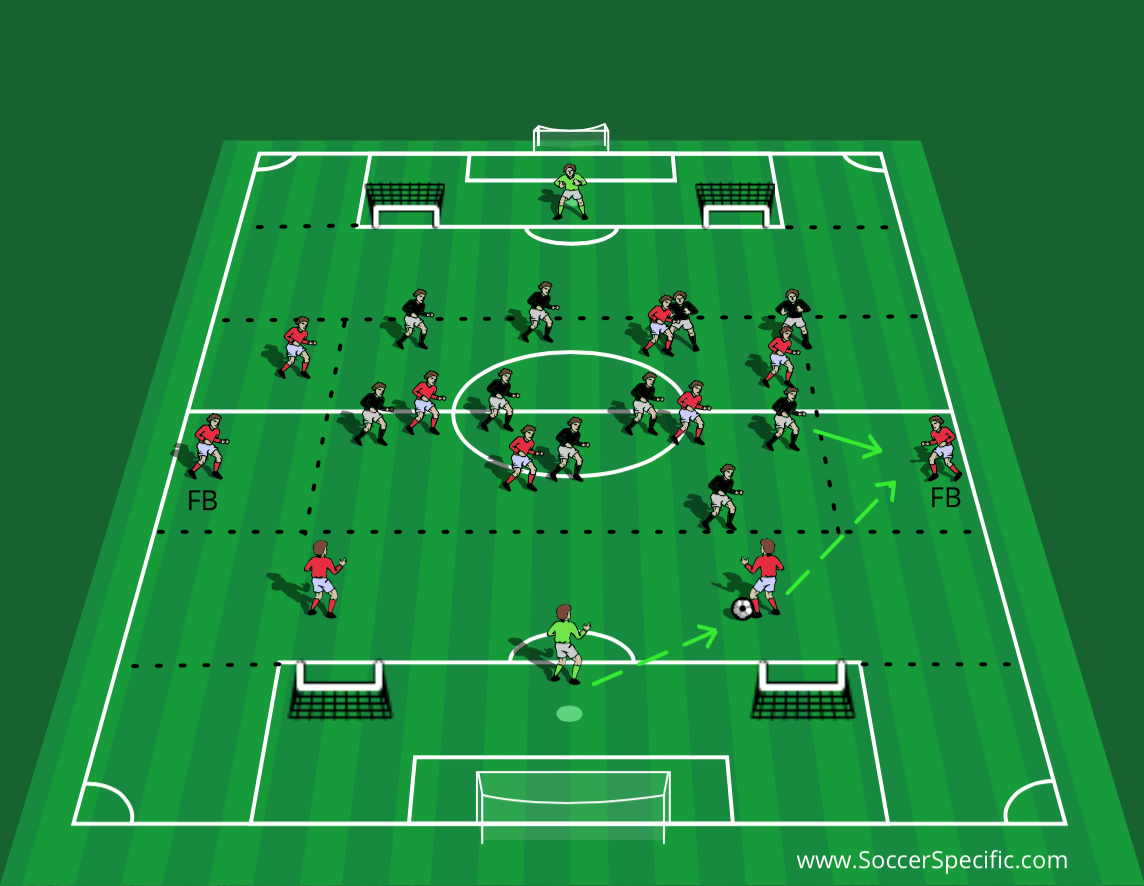
Instructions:
DEFENSIVE ORGANISATION – Central Compactness:
Play starts with the Goalkeeper each time; only Central Defenders can drop into end zone to receive passes; only Fullbacks or wide Midfield players can enter side channels (2-touch play in side channels)
Emphasis is on Defensive team remaining in the central zone – being compact + patient to prevent the opponent playing through central areas.
If the ball is passed into a side channel the defensive team must apply immediate pressure. If winning possession; immediate transition to attack.
Coaching Points:
- DEFENSIVE TEAM:
- Stay Compact centrally – any attempt to penetrate by opponent must be met with aggressive pressure.
- Allow the pass to wide channel then immediate pressure.
- Communication is vital
- POSSESSION TEAM(S):
- Quick ball circulation and movement.
- 2-touch play in wide channels.
5.
Setup:
11v11 Organised; pitch divided into zones as shown.
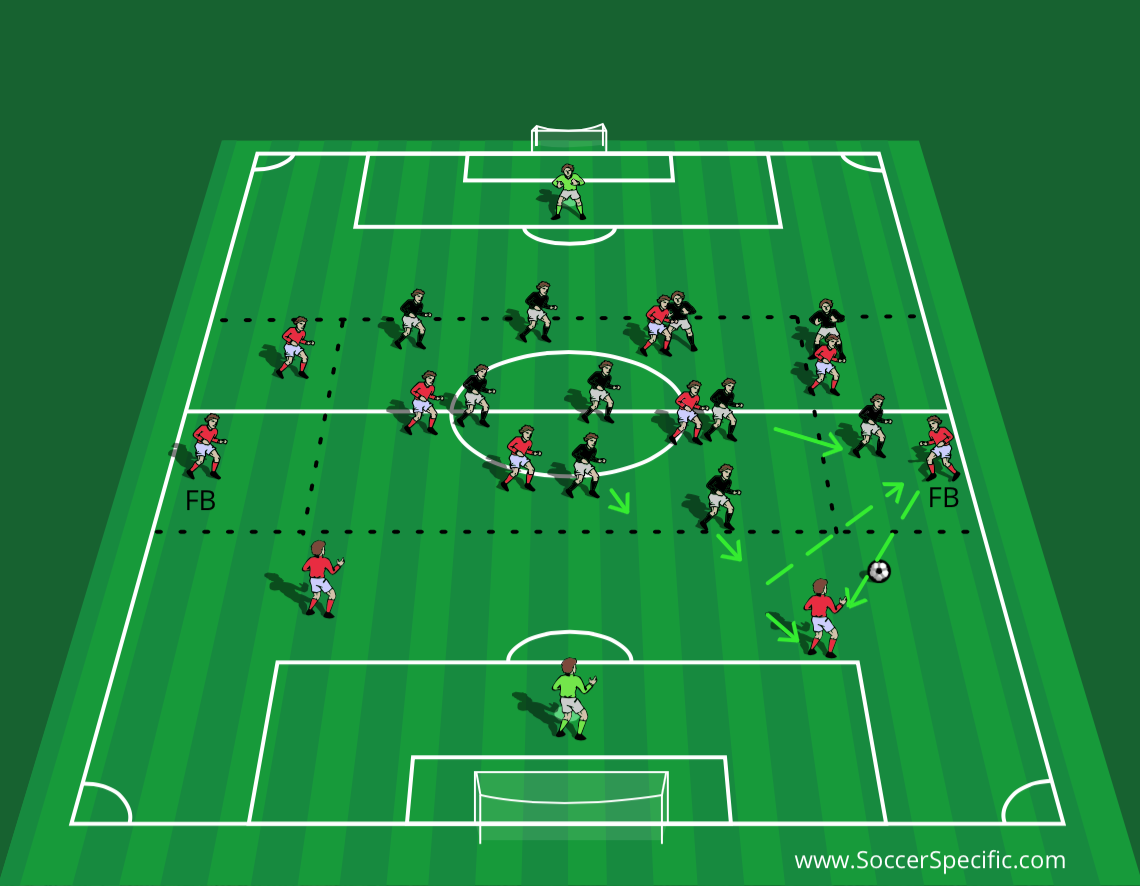
Instructions:
DEFENSIVE ORGANISATION – Central Compactness:
Play starts with the Goalkeeper each time; only Central Defenders can drop into end zone to receive passes; only Fullbacks or wide Midfield players can enter side channels (2-touch play in side channels)
Emphasis is on Defensive team remaining in the central zone – being compact + patient to prevent the opponent playing through central areas.
If the ball is passed into a side channel the defensive team must apply immediate pressure. On any backs to Central Defenders; Strikers must immediately enter end-zone to Press.
If winning possession; immediate transition to attack.
Coaching Points:
- DEFENSIVE TEAM:
- Stay Compact centrally – any attempt to penetrate by opponent must be met with aggressive pressure.
- Allow the pass to wide channel then immediate pressure.
- Communication is vital
- POSSESSION TEAM(S):
- Quick ball circulation and movement.
- 2-touch play in wide channels.
